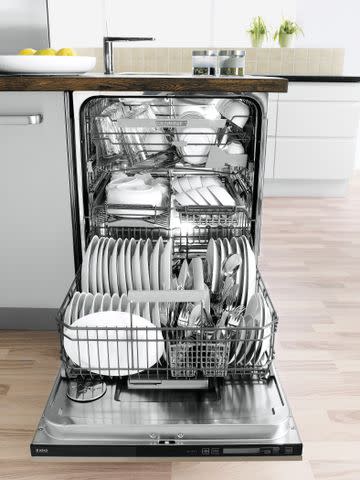How to Load a Dishwasher, the Correct Way
This housekeeping duty only requires five simple steps.
A dishwasher is one of the most time-saving appliances in your kitchen, especially if you have a large family or a knack for entertaining. But are you using it correctly? Piling dirty dishes into the appliance straight from the table can be a recipe for disaster. Not only can the machine malfunction, but water spots and grime might make an appearance on dishes and cutlery.
Each model is different, so what works for some dishwashers might not for others. But all dishwashers use a series of spray arms to rotate and distribute water throughout a cycle. For a proper wash (and dry), there should be no obstructions that keep the water jets from touching the dishes. Spacing is also important. Here is a guide to loading a dishwasher correctly and making the most of its benefits.
Related: Does a Dishwasher Save Water? Yes—Even If It’s Not Quite Full

Better Homes & Gardens
1. Learn Your Machine
Most dishwashers have the same basic layout, but some vary depending on the model. Read the manufacturer's instructions to learn more about where the jets are aligned, the water temperature on each setting, and the best type of dishwashing soap (liquid, powder, pods, or gel) for your particular model.
Related: The 9 Best Dishwashers of 2023 to Cut Down on After-Dinner Cleanup
2. Only Load Dishwasher-Safe Items
Scrape leftovers into the trash and soak burnt pots and pans as needed. Before running the dishwasher, make sure your cookware is dishwasher-safe; you might be surprised that many things are not. Antiques, such as porcelain china, should not go in a dishwasher. Neither should aluminum, cast iron, brass, tin, and bronze metals. Nonstick pots and pans, wooden cutting boards or utensils, and even some plastics can also be damaged in a dishwasher. When in doubt, handwash these items instead.
Related: 16 Things You Never Knew You Could Clean in Your Dishwasher

Better Homes & Gardens
3. Load in an Orderly Fashion
The heating element of your dishwasher and water pressure work together for a good clean. Placing items in an orderly fashion ensures the best results. The dishwasher jets spray upwards, so dishes should be positioned with the dirty side facing down and angled towards the center of the dishwasher. Avoid overcrowding to ensure water can reach dirty surfaces and drain off.
Dishes should never face the exterior walls of the dishwasher. Mixing pans, bowls, and other large items should be placed at the back of the bottom rack. Load small plates to fill any gaps. Try this dish placement in your dishwasher:
Glasses and Plastic Containers: Glasses, cups, small bowls, and other dishwasher-safe plastics go on the upper rack. The spray arms shoot jets of water upwards, so load cups and glassware facing downward.
Utensils: Long kitchen utensils, like spatulas and serving spoons, should be loaded on the side of the upper rack.
Silverware: All silverware, including spoons and forks, goes into the utensil basket. Place knives with the handle up to make unloading safer. To avoid nesting or sticking utensils, which make it hard for the dishwasher to properly clean cutlery from all sides, mix forks and spoons in each compartment of the basket.
Pots, Pans, Plates, and Bowls: Pots, pans, serving bowls, plates, and other large items go on the bottom rack, at the back, and along the sides to allow water to flow freely across all items. Bowls should be loaded face-down in the dishwasher.
After being soaked, heavily soiled items should also be placed in the bottom rack, where the water pressure is slightly higher, as it has a more substantial cleaning capacity.
4. Use the Right Detergent
Before starting the ideal cycle for the soil level, be sure to use the right dishwashing detergent. There are lots of dishwasher products out there, including tablets, powder, and liquids, but the manufacturer’s label should help determine which will perform best in your model. Avoid dish soaps, as they can damage the appliance.
5. Unload from Bottom to Top
While it's tempting to start with the lighter items in the top rack, it is best to unload a dishwasher from the bottom to the top. This prevents residual water hiding in bowls and cuts from tipping over and spilling onto clean dishes below.
Related: Is It Better to Use the Air-Dry Setting on Your Dishwasher?

Tria Giovan
Dishwasher Safety and What Not to Do
Though this is one of the most common recommendations, many people overlook loading sharp objects, like knives, pointing downwards. Injuries from knives pointing up are easily avoidable, so always place knives with the handle up to make unloading safer. Talking about safety tips, avoid overcrowding glassware or glass food storage containers, especially thin, delicate ones, as these can break or chip once the machine starts its cycle. Finally, let your dishwasher completely cool off before unloading—burns from the steaming tend to happen quite often (either if you reach out to open the dishwasher door too quickly after it has finished or by mid-cycle).
Additional Tips for Loading a Dishwasher
If you are following all of these steps but still pulling out dirty dishes, try these tips to identify and fix the problem quickly.
Check that nothing is blocking the spray arms.
Load fewer dishes per cycle if your dishes keep coming out dirty. Make sure each dish is well-spaced to let water and soap pass.
Use a dishwasher cleaner to deep-clean the dishwasher once a month.
Clean the dishwasher filter every three to six months.
Every three months or so, run a dish-free cycle with apple cider vinegar or distilled white vinegar. This will help eliminate stains.
Use a water softener if your home suffers from hard water.
For more Better Homes & Gardens news, make sure to sign up for our newsletter!
Read the original article on Better Homes & Gardens.

